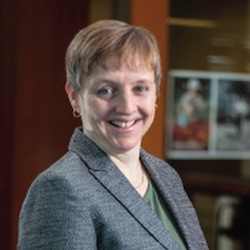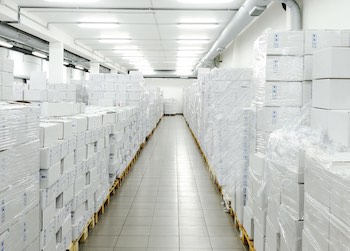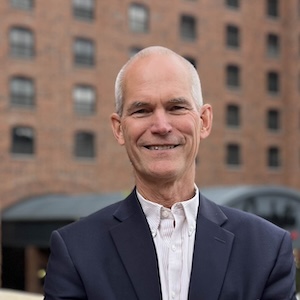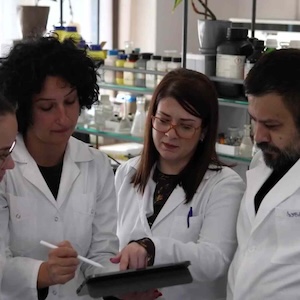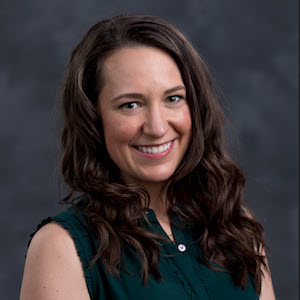We learned a lot about the two topics during a conversation with the new Director of Graduate Studies for the MPS in Applied Science Leadership, Jennifer van de Ligt.
Who Should Consider the Applied Science Leadership Degree?
This degree is designed for early and mid-career professionals, but recent bachelor's degree recipients will also benefit from the program. Although the program may be taken full-time, it is designed for students who are working adults so that they may apply the program concepts immediately on the job to advance their careers.
“Even though the program is fully online,” van de Ligt says, “you interact with the instructors regularly. Some of the courses have synchronous parts with instructor-led discussions and some don’t. Even during the asynchronous parts, you move through the content in a paced manner with your classmates. This allows you to learn from your peers’ experiences as well as contribute your experiences just like you would in a traditional classroom.”
Why Is There a Need for a Degree Like This?
It’s all about leadership and preparedness.
Trained leaders in applied science are critical right now. The AScL degree helps students gain a “broader perspective so that they can see relationships, disruptors, and opportunities in a more holistic manner and have the leadership skills to articulate them in their professional roles. Leaders training in the applied sciences approach will be able to see a problem from multiple perspectives and think two or three steps ahead as they plan and propose solutions.”
"The AScL degree... will give you more tools in your toolbox to operate on a broader scale, so that you can truly lead through moments of change and crisis.”
Educators and institutions tend to think mainly about producing scientists and engineers, van de Ligt continues. The AScL degree not only acknowledges that you may already be an expert, but it will expand your knowledge to “give you more tools in your toolbox to operate on a broader scale, so that you can truly lead through moments of change and crisis.”
As the world is experiencing now, moments of change are all around us. Whether it’s a public health crisis, a local emergency, or just making the world a better place, we need qualified leaders in applied science—leaders adept at transitioning basic science concepts into real-world applications and understanding. These leaders must be comfortable with using and interpreting science in order to “understand who to believe and why you believe them, and communicate that to the stakeholders you’re working with.”
For example, one of the core certificates currently in the AScL program is the Integrated Food Systems Leadership certificate. The students in the certificate program, many of whom work within the food system, have learned firsthand this year how important this applied science leadership framework is as they helped their employers, communities, and families respond to disruptions in the food supply during the pandemic. (The other core certificate in the AScL program is the Leadership for Science Professionals.)
What Has the Pandemic Revealed about the Food System?
As director of the Food Protection and Defense Institute, van de Ligt has a unique perspective on how the pandemic affected the food system. She wrote several reports to help the government and public and private sectors navigate the supply chain disruption. One report even made it to a White House briefing.
"All the food that was being eaten away from home at restaurants and work places now had to be eaten at home."
“What is certain in this pandemic” van de Ligt says, “is that what it looked like in March is not what it looked like in April, and it is not what it looks like today. We are continuing to iterate and refine and try new ideas and paths to lead through change. Learning and honing the leadership skills to do that is part of what the AScL program provides.”
“Specifically, the food system received bigger shocks than it ever anticipated,” she says. “One of the key hallmarks immediately prior to the pandemic was that there was slightly more food being eaten away from the home than eaten in the home. Then everything shut down, so that meant that all the food that was being eaten away from home at restaurants and work places now had to be eaten at home. This placed tremendous pressure on the supply chains serving grocery stores and food assistance networks.
“That’s why you saw, and are still seeing, empty shelves and foods out-of-stock at grocery stores. When people were locking down, they were treating it like a snowstorm or a hurricane or a tornado and stocking up for several weeks. The grocery store can restock and prepare for events like that and get through a week or two, but now it’s continuous when people are uncertain as to when they’ll be able to go back out again.”
In normal disaster recovery, she continues, people would go back to work and resume their 50 percent of food outside the home, and grocery stores would restock. With the pandemic though, there are still many people still out of work or working from home.
So why is this crisis different? It’s all about adaptability.
“It’s really easy to pick up retail foods and move them into food service; it is virtually impossible to pick up food service foods and move them into retail. With food service products, you’re talking about 25-pound bags of flour, 20-pound cases of chicken breasts, 10 pound bags of shredded cheese. Most consumers are not able to handle this quantity in their home.
"It’s also hard to change the manufacturing equipment to package the smaller sizes, and packaging materials are usually ordered several months in advance. In addition, the required labeling on that packaging is different in food service than it is in retail. So even if consumers would purchase that 10-pound bag of shredded cheese, it would not be labeled correctly for sale directly to a consumer."
The result? Eventually, just as we’ve seen in so many other areas, the industry pivoted.
“They figured it out. Regulatory agencies provided flexibility on how foods could be labelled and packaged. We saw the big five- or ten-pound bags in the grocery store. What I think is amazing is that we never had a food shortage in the country; we had a food distribution disruption and spot outages, but overall, everybody continued to have access to food. It’s really a success.”
The food industry has also used the pandemic to rethink its commitment to worker safety. “The active management of worker health has increased exponentially to a level better than it’s ever been in this country. I think we’ll continue to see an emphasis on worker health and hygiene even as the country recovers from the pandemic. This is an aspect I hope stays with us.”
How does this apply to you and me?
The obvious answer is that we all eat. “You can’t opt out of the food system,” van de Ligt says.
The food system is complex, multilayered, touches nearly every profession. So even if you don’t think your area of expertise relates to the food, you may be surprised.
“You can’t opt out of the food system."
“If you think about the food system as a whole—we have primary producers growing crops and animals, food manufacturing companies, and retail and distribution (grocery stores, restaurants, etc.)—that’s the core. But if you think beyond that... the food system has HR professionals, and marketing, advertising, and sales. It has environmental health and safety workers. It has construction designers and builders, pubic health experts, crop scientists, entomologists, nutritionists, bakers, chefs, food scientists... It has graphic designers and logistics, supply chain, procurement, and finance experts. There are very few types of disciplines that do not touch food in one way or another. Even space travel has a food component.”

